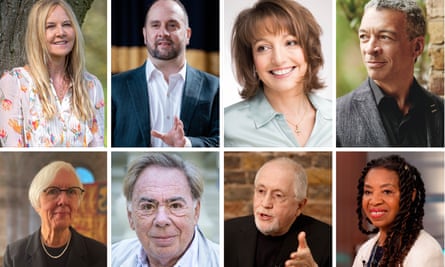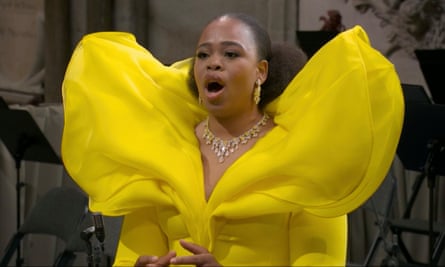Standards and premieres galore as music takes centre stage at coronation | King Charles coronation
[ad_1]
Perhaps fantasising about your coronation is as standard for future monarchs as imagining your wedding for lesser mortals. If so, Charles III had plenty of time to think it through. His choice to enter Westminster Abbey to the rousing choral explosion of Hubert Parry’s anthem I Was Glad, composed for Edward VII’s big day in 1902, certainly suggests a man keen to make an entrance.
From the intricate choreography to the glittering array of monarch-making accoutrements – ring, glove, orb, sceptre – symbolism was also going to take centre stage. It’s why Charles’s involvement in selecting the music has attracted attention, and why there was so much of it. Every broadcast-ready historic event needs a soundtrack.
No matter when you tuned in, you’ll have heard some of it. If you were lucky, you might even have caught the unforgettable sight of tuba-playing on horseback amid the miscellaneous marches and repeat airings of the national anthem.
Inside, there were standards aplenty. Handel’s Zadok the Priest, for instance, was written for George II’s coronation and has been heard at every one since. Here it provided a massive injection of energy as Charles disappeared behind the anointing screen. It was also one of many examples of near-miraculous coordination between the choir directed by Andrew Nethsingha and the specially assembled Coronation Orchestra, crammed into the organ loft with its conductor, Antonio Pappano. And long live BBC sound engineers, whose virtuosity deserves its own write-up.

There were also 12 new commissions. In one coronation first, the bass-baritone Bryn Terfel sang Paul Mealor’s Kyrie Eleison in Welsh. In another, the Ascension Choir gospel outfit performed part of Debbie Wiseman’s Alleluia unaccompanied, swaying in sync. The quality of performance was superb. But of the new compositions, only the unfurling melodic lines and understated beauty of Tarik O’Regan’s Agnus Dei exceeded the blandly forgettable – a tendency masterfully encapsulated by Andrew Lloyd Webber’s Make a Joyful Noise.

Most of the new pieces and many of the old, however, appeared in a separate sequence before the main event, like a playlist for a party too grand for Spotify. Only snatches were included in the TV coverage. We joined the English Baroque Soloists midway through some gloriously airborne Bach and there was a flash of impassioned Bruckner from the Monteverdi Choir.
In a rare human moment, we saw the Master of the King’s Music, Judith Weir, listening to her tender, folk-inflected commission Brighter Visions Shine Afar with her eyes closed, head moving gently in time.
The rest was largely faded out, making space for military manoeuvres. As drums were beaten and fanfares sounded, the commentators marvelled that music was essential for battlefield morale. Back in the 21st century and amid current arts funding crises, the coronation’s musical symbolism remained equivocal.
Music was almost constantly present but often hidden, treated as peripheral until it was needed to deliver on the grandest scale. Yet to step into the spotlight at such vital moments, musicians need to be trained and supported, their world-class skills recognised and celebrated – not as the result of miracles, but of phenomenally hard work.
[ad_2]
Source: News
